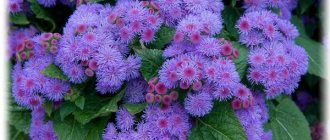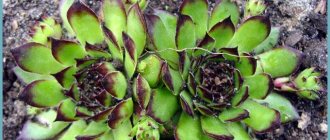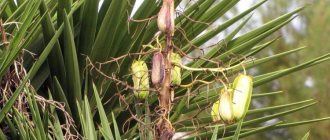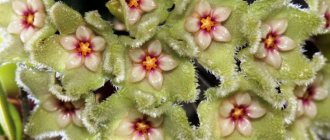Rhipsalis belongs to the cactus family, but outwardly it resembles a cactus very vaguely.
And in general, it’s hard to imagine a more unusual succulent, because it grows not in a distant hot desert, but in the humid tropical forests of distant Brazil, and instead of sharp thorns it has soft hairs. And the uniqueness of the plant does not end there. Let's find out more about him.
Under natural conditions, rhipsalis settles on old trees, tightly clinging to branches and bark with its aerial roots. In addition to trees, it grows on wet rocks: the soil in this case is the remains of organic matter that collect in rock crevices. Habitat: Madagascar, Sri Lanka, Central Africa and Brazil. At home, rapsalis is easy to care for and can be propagated by seeds and cuttings without much difficulty.
Varieties and photos
Below are photos and descriptions of rhipsalis species suitable for propagation and care at home.
Cassuta (empty-fruited) (Rhipsalis cassutha)
Ampelous appearance, with soft rounded shoots consisting of segments and bright red small fruits. The shoots reach a length of 2-3 meters and are highly branched . The flowers are small, white and odorless. The photo below shows Rhipsalis Cassuta:
Hairy (Rhipsalis capilliformis)
Unlike cassuta, this variety has short shoots - only 50-60 cm in length, but also consists of oval flat segments similar to leaves. The variety is epiphytic. Blooms with small white buds. You can see what the Volosovidny variety looks like in the photo below:
Pilocarpa (Rhipsalis pilocarpa)
The stems look like hard tubes covered with yellow hair. They reach a length of 50-60 cm. The variety is capable of blooming several times a year. In the photo below is the rhipsalis variety Pilocarpa:
Description of cacti of the genus Rhipsalis
The genus Rhipsalis is an epiphytic (forest) cacti that naturally lives on trees. But some of them are lithophytes, that is, they grow in rock cracks. There are just under 40 species in nature, and most of them are found in Brazil. Some of them are widespread in South and Central America, the Caribbean islands, and another species, Rhipsalis baccifera, can be found in Madagascar and Sri Lanka, making Rhipsalis the only member of the Cactus family that occurs naturally in Africa and Asia. The scientific name of the genus "Rhipsalis" comes from the ancient Greek word for "weaving", which describes the peculiarity of the plant's morphology.
Most varieties of Rhipsalis cactus develop cylindrical stems that are often branched and drooping, but some species have flattened or erect stems. Visually, the plant looks like a small bush ranging in size from 40 cm to 5 m. In the wild, the cactus can reach a length of more than 6 meters. Most species have no spines; some have very small bristles. In natural conditions, these cacti usually grow on trees, although some species grow on rocks or in the ground.
Blooming house cactus Rhipsalis
Prutovik blooms in nature in the first months of the year, but at home you can expect buds to appear at the beginning of the growing season.
The cream or white flowers are odorless and usually small, measuring 5mm. After flowering, transparent white berries about 6 mm wide appear. These berries are sometimes called "glass beads" due to their translucent appearance.
These epiphytic cacti grow “attached” to other plants in the wild. They feed on rotting leaves and moss. Because of this, as well as the type of fruit, they are often called Mistletoe cactus.
Although some Rhipsalis are grown commercially and can be purchased at garden centers, other species are extremely rare.
Is Rhipsalis cactus toxic to people and animals?
The twig is non-toxic to residents and pets, and the ripe berries are edible and have a sweetish taste.
Care
Priming
It is easy to buy at any flower shop - it is a universal soil for growing succulents and cacti.
You can make it yourself from the following components:
- river sand, peat soil, leaf soil and turf - in equal parts;
- humus and garden soil, coarse sand, peat - also in equal parts;
- peat, humus and leaf soil (equal parts), a handful of charcoal and finely chopped sphagnum moss.
For drainage, use small sea pebbles, broken red bricks or expanded clay. The layer should be at least 1/4 of the pot.
Do not forget to calcine the soil in the oven or treat it with a weak solution of potassium permanganate - this will help destroy the pest larvae.
Top dressing
Fertilizers can be applied from March to October - this is the time when rhipsalis is actively growing. Choose liquid mineral fertilizer for succulents and cacti. The recommended frequency is once every 2 weeks, after watering. If special fertilizer cannot be obtained, buy any flower food, but in this case you will need to reduce the permitted dosage by 2 times. If you keep rhipsalis in a cool room during wintering (from October to March), you do not need to apply fertilizer.
Excess nitrogen negatively affects the condition of the plant - keep this in mind.
Lighting
Rhipsalis was brought to our region from tropical forests, so it does not tolerate direct sun.
If you leave the plant on a south window, it will quickly die, so only western and eastern ones! But even there the plant will need to be shaded.
However, even on a northern window, rhipsalis is able to grow and maintain an attractive appearance , but only with the organization of additional lighting.
Temperature
At temperatures from +18 to +25 degrees, rhipsalis will be quite comfortable, but do not forget that if you give your green pet a few months to rest, it will look even more beautiful. This is done as follows: the pot with the plant is transferred to a cool (+15-17 degrees) room and left there until spring, without bothering with fertilizing and frequent watering. Lower temperatures cause the development of diseases and often lead to the death of the crop.
However, even without wintering, rhipsalis is able to grow well - so don’t worry if there is no opportunity for wintering.
Watering and humidity
The peculiarity of tropical forests is high air humidity. It is difficult to organize such an atmosphere in an ordinary apartment, but it is quite possible. Firstly, place the pot with rhipsalis on a tray with wet expanded clay or pebbles , and secondly, give your cactus a warm shower once a month, and spray it with a spray bottle once a day.
Transfer
Replant young plants every spring for the first 3 years, then every 3-4 years.
If the rhipsalis has grown greatly, there is no need to replant it at all, but only remove the top layer of soil and replace it with a new one. For replanting, select a new container - wide, but shallow (after all, the roots of the plant are located close to the surface). Transplantation is carried out using the transshipment method. The new soil is loose and light, neutral or slightly acidic in reaction.
Briefly about the conditions for growing rhipsalis
Rhipsalis blooms, as a rule, in the last month of winter or in the first spring. If this crop is grown correctly, and all basic recommendations for caring for the plant are followed, then rhipsalis can bloom more than once, but several times a year.
Rhipsalis shows good results in light shade, as well as with a large amount of diffused light. It is best to place the pot with the plant on a window with eastern or western exposure. At the same time, aggressive direct sunlight that appears at noon should not hit the plant.
In spring and summer, the temperature should be maintained within +20 +26 degrees. As for winter, at this time the temperature should be lower and reach approximately +16 degrees. Moreover, this indicator in winter should not be lower than ten degrees.
The rhipsalis plant needs to be watered regularly. This is done after the soil has dried out by a third.
In order for rhipsalis to develop well and gain growth, it is necessary to maintain environmental humidity at a high level. It is best to use a special device that increases this indicator in the room. In addition, you can pour expanded clay or pebbles into a bowl and pour water on top. A pot with a plant is placed on such a container.
The application of nutrients begins in March and ends in October. As a rule, this procedure is carried out a couple of times in thirty days. For this purpose, it is best to use a complex of mineral-based fertilizers that are intended for species such as cacti and succulents. It is also possible to use other fertilizers in combination, but the concentration of the fertilizer must be halved. This plant does not require feeding from October until March.
In winter, after flowering has ended, rhipsalis enters a dormant period. It usually lasts from one to one and a half months.
When young, plants are replanted annually. As for adult rhipsalis, this procedure is performed less frequently for them, approximately once every four to five years. The plant is replanted by transshipment.
This crop is propagated by cuttings, seeds, and also by dividing the bush.
The rhipsalis plant can be attacked by scale insects and spider mites. Due to improper care, the plant may develop chlorosis.
Rhipsalis: photo
Bloom
You can admire the blooming of rhipsalis in late winter - early spring. Flowers dot the bush like stars in the firmament : they are painted in all shades of pink and white, and their petals are velvety to the touch and slightly pointed. The fruits are shaped like gooseberries, just as juicy, with dark seeds inside.
As soon as buds appear on the cactus, it should not be moved from place to place and the pot should not be turned over. Otherwise, the buds will fall off and you won’t see the flowers. But continue to care as usual.
This photo shows rhipsalis blooming:
General description of appearance
Rhipsalis is considered a unique succulent plant of the epiphytic (forest) cacti family. Among its other relatives, it is distinguished by its extraordinary appearance. The plant has many shoots, consisting of segments of various shapes (ribbed, flattened, cylindrical).
The botanical name of the plant is Rhipsalis. The name has Greek roots and translated means “weaving”, “twisting”. The homeland of the cactus is considered to be America, Africa, and South Asia, famous for its tropical jungles and climate with warm rains.
In nature, rhipsalis can be found in the tropics, where air humidity is high. These conditions are present in Africa, Southeast Asia, and North and South America.
Rhipsalis cannot be called poisonous. There is no recorded content of toxic substances in its composition. However, flower growers recommend following basic safety rules when working with the plant.
Reproduction
Seeds
Propagation by seeds is rarely carried out, because half of the seedlings simply do not appear. Please note that the material must be fresh.
- Soak the seeds in warm purified water with a small amount of potassium permanganate (for 3-4 hours).
- Sow the seeds in a mixture of peat and sand to a depth of no more than 1 cm. Cover the container with polyethylene and wait for rooting. Be sure to make several holes in the film for air, and moisten the soil with a spray bottle. Don't let it dry out!
- As soon as the seedling reaches 2-3 cm, transplant it into a separate container. Since young plants are very weak, do not leave them in direct sunlight, and loosen the soil more often.
Cuttings
The best propagation option is cuttings.
- Cut off a shoot 12-16 cm long from a healthy bush. Powder the cut area with activated charcoal or charcoal and dry it.
- Plant the cuttings in a mixture of peat and sand, moisten it and cover with glass or cling film. You can add support or lean the cutting against the wall of the pot. For germination, you need to maintain a temperature of +23-25 degrees, ventilate the greenhouse daily and spray it with water.
- After a month and a half, when the plant has roots, plant it in a separate pot.
How to propagate home cactus Rhipsalis
This plant can be propagated by two methods - seeds and stem cuttings.
If your cactus has bloomed and then formed fruits, you can wait until they are ripe, then crush them and collect the tiny seeds. Plant them approximately to a depth of 3 mm in a moist soil mixture. Make sure the container has drainage holes. The soil should be slightly moist. Seeds germinate in two to six weeks.
Once the seeds have sprouted, leave the plants in their current container for a few months. Once they are large enough to transplant safely, you can transplant them into larger containers.
Propagation of Rhipsalis by stem cuttings
For the greatest success, propagate the Rhipsalis flower during the growing season, from spring to summer. Using a clean, sharp tool, cut off a portion of the stem and place the cutting in a prepared container with a rich, well-drained potting mix. Deepen the cut end of the stem about 3-5 cm into the soil, firming the soil around the cutting. Water the soil and place the container in a warm location that receives bright, indirect light.
Rhipsalis cuttings should develop roots in about four weeks. After a few months, the root system should be fully developed. Care for cuttings as you would a mother plant.
Pests and diseases
Diseases rarely affect rhipsalis and almost always due to the owner’s oversight.
- Yellow coloration of the edges of the segments, pallor and slow growth indicate a lack of light.
- Have the shoots lost their elasticity and brightness? You obviously flooded your cactus and the roots began to rot. Try to treat it: take it out of the pot and cut off the damaged areas with a sharp blade, sprinkle the cut area with crushed activated carbon and transplant the plant into a fresh substrate. This procedure quite often benefits ripsalis.
- If a rhipsalis flower dries, its leaves decrease in size and fall off, the shape of the buds changes - it is affected by chlorosis. The cause of the disease may be a lack of nutrients (magnesium, iron, nitrogen, sulfur, calcium), an incorrectly selected substrate, or the use of poor quality water for irrigation. Transplant the plant into new soil with an acidity of 5-5.5 pH and water it with water with the addition of citric acid, and from time to time treat the above-ground part with fertilizer containing iron in chelated form.
The most common pests are red spider mites and scale insects. To begin, remove all pests with a cotton swab moistened with soapy water, then wash the flower in the shower and let it dry.
The next stage: treatment with either a folk remedy or a special preparation. If there are few insects, try the first option. For example, a decoction of cyclamen roots (50 g per 500 ml of water) or an infusion of onions (200 g of onion in a bucket of warm water, leave for 12 hours, strain and process immediately). A good effect is from an alcohol solution, specifically ammonia, which only needs 30 ml (they do not spray the leaves with it, but wipe the affected areas).
If the damage is severe, use insecticides: Actellik, Fitoverm, Aktara, Apollo.
Kinds
Cassuta or Emptyfruit
Rhipsalis of this species belongs to the ampelous plants. The shoots are divided into many segments hanging down. Characterized by abundant branching and flower formation. The flowers are predominantly cream-colored. At the end of flowering, bright red fruits are formed.
Pilocarpa
The shoots of this type of rhipsalis are thick, rounded, and have white hairs. Flowers are formed at the ends of the shoots. Flower petals are pointed and white. After flowering, berries are formed in place of the flowers. This does not reduce the decorativeness of rhipsalis. The contrast of scarlet berries and green shoots looks fascinating.
Horrida
The species is known as Rhipsalis Terrible. Decorative stems add value to the species. The shoots of the plant are numerous and thin, forming rather dense branches. The branches can reach 5–20 cm in length. The branches are covered with white hairs. Flowers and fruits are small and inconspicuous.
hairy
The species is distinguished by thin shoots divided into long segments. Branching of shoots is increased. The shoots can reach 1.2 m in length. Thanks to this, the bush resembles curls. The areoles have long white hairs from which small whitish flowers appear. The plant rarely blooms.
Cereuscula
Rhipsalis of this species may be known as Cereus or Candle-shaped. Most popular among flower growers. The shoots are thin and short. They grow mostly chaotically, in different directions.
Thanks to this, the rhipsalis takes on the shape of a three-dimensional lace. Long shoots have an arched shape. The flower can reach 20 cm in diameter. The flowers are mostly white. Flowering indoors is difficult to achieve.
Barchela
Flower growers call this species “coral” for its similarity. The shoots are divided into short segments. One shoot has 2–3 segments. The diameter of the segments is round.
The plant can be used as a decoration for an alpine hill or used in a design as an hanging cactus. Rhipsalis flowers are small yellow, and the stems are colored pink or yellow-brown.
Ramulose
The stems are purple. The secondary segments are characterized by a green tint, a flat shape, and a length of up to 10 cm. The areoles from which the buds appear are located at a distance of 2–3 cm. Then, in place of the flowers, fruits are formed in which the seeds ripen.
Pachyptera or Thickwing
A distinctive feature of the species is its thick, long shoots. In addition, flowering can be observed both at the tip of the shoot and along its entire length. The flowers are small and white. On the upper side the shoots have a juicy green tint, on the back they are pearly lilac.
Hathiora
It is valued by flower growers for its good branching of stems. During flowering, the shoots are strewn with small flowers of yellow, pink, and red. The stems generally grow upward.
Bassifera
The cactus is an epiphytic species. The stems reach a length of 2 meters. The shoots are colored green or brownish-burgundy. The stems grow downwards. Characterized by strong branching of stems.
The segments are narrow, cylindrical in shape. The length of the stem segments reaches 9 cm, the diameter is no more than 5 mm. Rhipsalis flowers are delicate, greenish-white. Flower formation occurs at the tops of the stems. After the flowering period ends, white fruits are formed.
Paradox
Rhipsalis Paradox is known to gardeners as Rhipsalis Strange. The appearance is quite unusual and strange. The ribs of the shoots are high, consisting of segments. The segments alternate with flat intervals.
Mix
Several types of plants are collected in pots with mixed rhipsalis. Externally similar varieties are selected for the composition. You can purchase either a ready-made composition or choose your favorite from the presented rhipsalis.
Bacifera
The rhipsalis trunk is strong, up to 15 cm long. Shoots extend from its top. The shoots have several sides. The side edges are painted green-gray or blue.
The shoots are divided into thick segments up to 2.5 cm long. The shoots grow downwards under the weight of their own weight. Up to 2–3 new shoots can form from one segment. The location of the areolas is dense.
They are covered with bristles and small reddish scales. White delicate flowers are formed at the tops of the shoots. In place of the flowers, round white-pink fruits are subsequently formed.
Ramulose red coral
Rhipsalis grows as a shrub. The appearance of the bush is very elegant. The specificity is brought by the flowing stems of a purple-red hue. It can be either an epiphyte, i.e. grow on other plants, or a lithophyte, i.e. grow successfully on stones and rocks.
Mikranta
Bushy plant. The shoots hang down, reaching a length of 1 meter. The stems are characterized by abundant branching. Each shoot is 5–10 cm long and 1.9–2.2 cm wide. The areoles are small, bristly. Flowers are formed on single shoots. The diameter of the flowers is 7–11 mm, length 8–9 mm. The shape of the flowers resembles disks, intensely colored white with a red center.
Gobelian
A distinctive feature of the species is the differences between the primary and secondary segments. Primary ones are characterized by a bend at the base. The secondary ones stretch up to 15 cm in length and have a narrow shape. Lack of lighting leads to rapid fading.
Gnarled
Rhipsalis got its name from the similarity of its shoots to cones. Flowers are formed at the ends of the shoots. The buds are large and white. The young plant grows with shoots upward. After a few years, the shoots droop under their own weight.
Differences between rhipsalis and hatiora
Both hatiora and rhipsalis belong to the same family - cactaceae, and are strikingly similar to each other from a young age. Mature plants are somewhat easier to distinguish . Firstly, they have different shoots: in hatiora they are erect, while in rhipsalis they hang down. Secondly, the segments that make up the stems are of different lengths: in hatiora they are short, in rhipsalis they are much longer.
And the last difference is in the buds. Hatiora flowers are large, bloom only at the ends of the segments, and are colored pink, red or yellow. In rhipsalis, they are small (no more than 2 cm in diameter), white or with a yellow tint.
Characteristics of rhipsalis
This crop is epiphytic and grows in the form of a compact shrub. It branches quite intensively and has aerial roots. The green part is covered with fluff. It is worth noting that all varieties lack spines.
The stems have a drooping direction and can have different shapes: round, flat or with ribs. The flowers are miniature, there is a corolla, which can be pink or yellow. There are also corollas with white and orange colors. Flowers are located both at the top of the shoot and along the entire stem. The fruits are shaped like berries. The fruits can have different colors: pinkish, snow-white and even black.
Rhipsalis cactus: photo
Signs and superstitions
There are many signs associated with this cactus, and most of them promise not the most pleasant changes. For example, it is believed that families break up because of it, and some esotericists do not advise keeping it in rooms where a man spends a lot of time. There is no reason to comment on a situation in which superstition defeats common sense, just like the information that rhipsalis is poisonous.
If a cactus is in the house of an unmarried girl, it promises her a quick wedding. In the house of a married woman, it promises the birth of a child: dark flowers - a boy, light flowers - a daughter.
If you already have children, the family can expect major purchases or replenishment of your wallet . By placing rhipsalis in the hallway, you will protect it from bad people and negativity.
It is also believed that cacti kill partners’ sexual attraction to each other, and males begin to reach for the bottle: the more flowers appear on the plant, the more vigorously the person drinks. If you want to give a cactus, choose a flowering one with soft spines, otherwise your relationship with the person will worsen. When choosing where to place a cactus, consider:
- Standing on a desktop, the cactus will absorb fatigue and irritation;
- In the kitchen - energy from family disagreements and quarrels;
- A cactus growing in the hallway will scare away bad people from your doorstep.
Is the plant a succulent?
Rhipsalis is a member of the cactus family. A succulent is not a species or genus of plants. When we talk about succulents, we mean the plant's ability to retain moisture and tolerate long-term droughts.
Thus, rhipsalis is a type of cactus. It would be a stretch to call it a succulent, since, apart from succulent stems, rhipsalis has no other characteristics.
The same cannot be said about its belonging to cacti, the distinctive feature of which is areoles covered with spines or bristles, inherent in all types of rhipsalis.
Photo gallery
vetkinsad
ingadarenskaya
katerinailinich92
vika1345
design.its.my.life
succulents_tver69
Care errors and their elimination
The table contains information that is worth paying attention to. It is the incorrect care of an unusual cactus that provokes various types of negative phenomena:
| Problem | Causes | Elimination |
| The shoots turn yellow and dry out | The development of a dangerous disease - root rot due to excessive watering. High dry air, infrequent watering | Remove rotted areas of roots, treat with fungicides (Topaz, Fundazol, Skor), transplant the rhipsalis into a new flowerpot, having previously arranged a drainage layer. Stabilize watering, prevent soil from drying out and heat in the room |
| Rotting | Excess moisture in the soil and air. Water stagnates in the pan. The owner waters the forest cactus more often than expected. Spraying is carried out in a cool room, water droplets dry out for a long time, accumulate in the center, near the root zone, and rotting begins | Normalize plant care, do not disturb the water regime |
| Doesn't grow | There is not enough light in the room. Poor soil | Move the forest cactus to a well-lit area. Replace the substrate taking into account the recommendations specified in the subsection “Soil and drainage” |
| The plant sheds segments | The room is too cold, the temperature has dropped below the permissible values: in summer - less than + 18 ° C, in winter - less than 10 ° C | Move the flowerpot to a room or other room where the indicators meet the norm for a particular season. |
| Doesn't bloom | The main reason is that the flowerpot with rhipsalis is often moved. Other factors: there is no rest period. The housewife applies more nitrogen fertilizers than necessary (yellowing of the stems and diseases are also possible with excess nitrogen) | Stop negative factors |
| Rhipsalis segments wrinkle | Excessive soil moisture | Normalize watering level |
Common growing questions
Does rhipsalis have spines? The twig is characterized by bare stems, without thorns. Some varieties have soft whitish fibers on the surface. The pilocarp rod is covered with yellowish hairs.
Which pot is better? The pot for the plant should be selected in accordance with the natural habitat conditions. The cactus is most often represented by an epiphytic plant that has a superficial root system. In this regard, you need to select a shallow pot for it. The container should be wide and slightly larger than the previous pot.
What is the lifespan of a flower? In indoor floriculture, with proper care, a flower can live for several decades. The cause of death of the twig is diseases, pests and violation of living conditions.
The home cactus is easy to care for, so every flower lover can keep it at home. Hanging varieties will be an excellent decoration for any corner of the apartment, and lush flowering will make the green shoots even more decorative.











